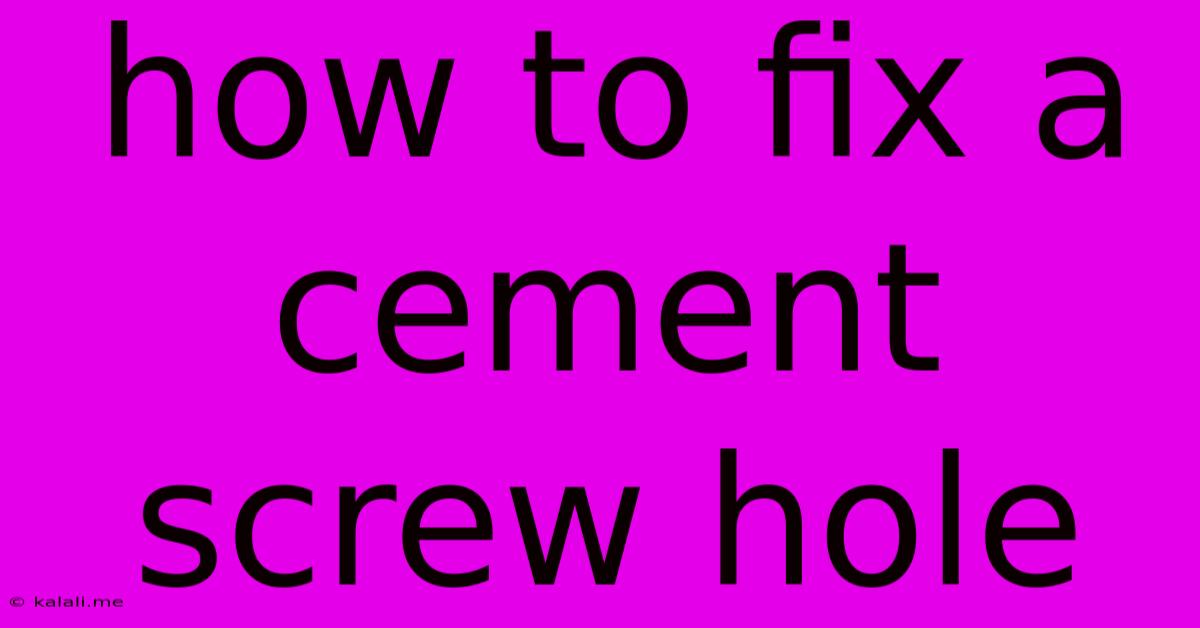How To Fix A Cement Screw Hole
Kalali
May 31, 2025 · 4 min read

Table of Contents
How to Fix a Cement Screw Hole: A Comprehensive Guide
Meta Description: Learn how to repair damaged screw holes in cement effectively. This guide covers various repair methods, from simple patching to more complex solutions, ensuring a strong and lasting fix. We'll cover everything from choosing the right materials to the proper techniques for a professional finish.
Fixing a stripped or damaged screw hole in cement can seem daunting, but with the right approach and materials, it's a manageable DIY project. Whether it's a loose screw in your garden fence, a wobbly handrail, or a damaged fixture in your concrete wall, this guide will walk you through various methods to effectively repair the damage and restore structural integrity.
Assessing the Damage: The First Step
Before jumping into repairs, take a moment to evaluate the severity of the damage. Consider these factors:
- Size of the hole: A small, slightly enlarged hole is easier to fix than a significantly damaged one.
- Depth of the hole: Deeper holes require more filling material and careful consideration.
- Location of the hole: Accessibility will impact your choice of repair method. A hole in a high-up area might require different tools and techniques than one at ground level.
- Structural integrity: Is the surrounding cement weakened or cracked? This might require more extensive repairs beyond just filling the hole.
Methods for Repairing Cement Screw Holes
Several methods exist for fixing damaged screw holes in cement, depending on the severity of the damage.
1. The Simple Patch (for minor damage):
This method is best suited for small, shallow holes where the surrounding cement remains intact.
- Clean the hole: Remove any loose debris or old mortar from the hole using a wire brush or small scraper.
- Apply epoxy putty: Choose a strong, fast-setting epoxy putty designed for concrete repairs. Follow the manufacturer's instructions for mixing and application. Firmly pack the putty into the hole, ensuring it's flush with the surrounding surface.
- Let it cure: Allow the epoxy putty to fully cure according to the manufacturer's recommendations. This usually takes several hours.
- Redrill the hole: Once cured, carefully redrill a new pilot hole in the repaired area, using a slightly smaller drill bit than your original screw.
2. Using Concrete Repair Mortar (for moderate damage):
For larger holes or those showing signs of significant damage, concrete repair mortar provides a more robust solution.
- Prepare the hole: Clean the hole thoroughly and slightly enlarge it to improve adhesion. You might need to use a hammer and chisel to remove any loose or crumbling cement.
- Apply the mortar: Mix the concrete repair mortar according to the manufacturer's instructions. Pack the mortar firmly into the hole, ensuring complete filling. Lightly dampen the surrounding area to improve adhesion.
- Level the surface: Use a trowel to create a smooth, even surface, ensuring the repair blends seamlessly with the existing cement.
- Cure the mortar: Allow ample time for the mortar to fully cure, protecting it from extreme temperatures and direct sunlight during this period.
- Redrill the hole: Once cured, carefully redrill a new pilot hole for your screw.
3. Using Anchor Bolts (for severe damage or heavy loads):
For significantly damaged holes or areas needing to support heavy loads, installing an anchor bolt offers superior strength and reliability. This method requires more advanced tools and skills.
- Enlarge the hole: Drill a larger hole to accommodate the anchor bolt.
- Insert the anchor bolt: Use a suitable anchor bolt designed for concrete. Insert it firmly into the hole.
- Secure the anchor bolt: Follow the manufacturer's instructions to securely fasten the anchor bolt into the cement. This might involve using special setting materials or adhesives.
- Attach the screw: Once the anchor bolt is securely in place, attach your screw.
Choosing the Right Materials: Key Considerations
Selecting the appropriate materials is vital for a successful repair. Consider factors like:
- Strength and durability: Opt for high-quality epoxy putty or concrete repair mortar designed for exterior applications if necessary.
- Setting time: Choose a material with a suitable setting time to minimize disruption.
- Color matching: Select a product that closely matches the color of your existing cement for a seamless finish.
Prevention is Key: Tips for Avoiding Damaged Screw Holes
Preventing damaged screw holes is always easier than fixing them. Here's how:
- Use the right size drill bit: Always use a drill bit slightly smaller than the screw diameter to avoid stripping the hole.
- Use the correct type of screw: Employ screws designed for concrete applications.
- Apply sufficient pressure: Ensure the screw is driven in straight and firmly without applying excessive force.
By following these steps and choosing the right materials, you can effectively repair damaged screw holes in cement, restoring functionality and aesthetic appeal to your project. Remember safety first – always wear appropriate safety gear when working with tools and materials.
Latest Posts
Latest Posts
-
What Level Can You Appraise Pokemon In Pokemon Go
Jun 01, 2025
-
I Have Some Errands To Run
Jun 01, 2025
-
1 Cu Ft Of Water Weighs
Jun 01, 2025
-
How Much Lemon Juice In 1 2 Lemon
Jun 01, 2025
-
Para Que Quieres Saber Eso Jaja Saludos
Jun 01, 2025
Related Post
Thank you for visiting our website which covers about How To Fix A Cement Screw Hole . We hope the information provided has been useful to you. Feel free to contact us if you have any questions or need further assistance. See you next time and don't miss to bookmark.